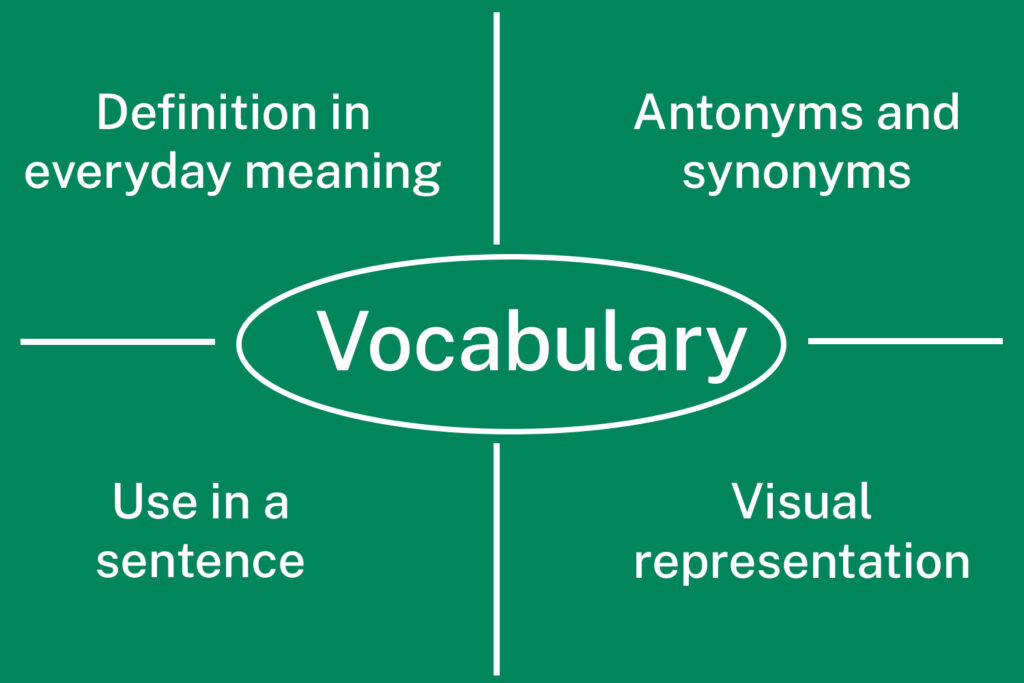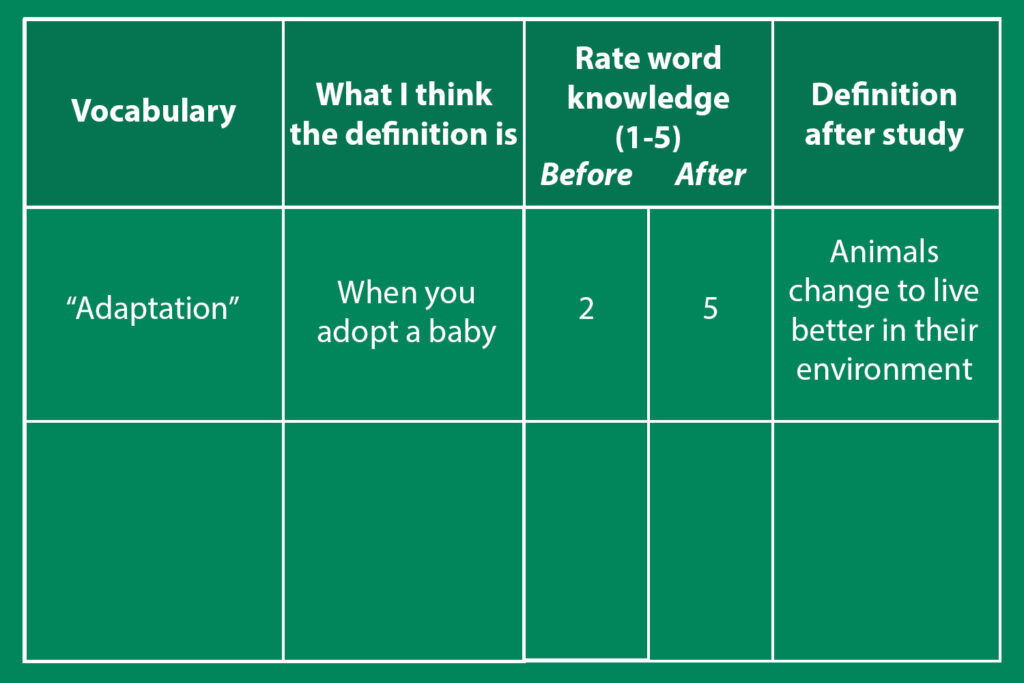Blog: How can teachers help EAL students build vocabulary?
Vocabulary development is vital for those using English as an additional language. Sheila Hopkins considers how teachers can identify key vocabulary during lesson planning and outlines strategies for teaching these key words to EAL students.
Key sections in this article:
- What are the different tiers of vocabulary?
- Learning vocabulary for instructional purposes
- Learning vocabulary for different functions
- Different approaches to teaching vocabulary
- Other strategies for teaching vocabulary
- What the research says
“The limits of my language are the limits of my mind. All I know is what I have words for.”
– Ludwig Wittgenstein
When we think of it, language pervades everything we do in education, making vocabulary development a critical component of learning for all pupils, but especially for those using English as an Additional Language (EAL).
Indeed, learners using EAL look to us for the informed lexical guidance that will allow them to comprehend lesson content, pass exams and make meaningful contributions to all aspects of school life; both social and academic. As such, educators across subject areas, phases and stages cannot afford to leave vocabulary instruction to chance.
This article first suggests criteria that teachers can use to identify key vocabulary in lesson planning and then provides some strategies for teaching new vocabulary to learners using EAL.
What are the different tiers of vocabulary?
To assist teachers in selecting key vocabulary, scholars have proposed various criteria for analysing the lexical demands of a lesson. Beck, McKeown and Kucan (2002) have provided a widely used classification scheme for organising vocabulary into tiers:
- Tier I is comprised of everyday vocabulary. For example: Friend, dog, happy.
- Tier II is more advanced academic vocabulary with wide applicability across subject areas. For example: Next, schedule, identify.
- Tier III vocabulary are topic-specific terms used within a particular subject area. For example: Magnet, stem, roots.
Curriculum materials can provide a fairly reliable list of Tier III terms tied to and contextualised within subject areas, while often neglecting to mention Tier II terms that learners will encounter across the disciplines.
For example, in an information report on mammals, vocabulary such as “habitat”, “diet”, “characteristics” will predictably be highlighted. However, vocabulary necessary for pupils to understand and discuss information about mammals will not be clarified (“some mammals…” or “most”, “all”, “many”, “a few”). Moreover, we cannot assume that learners using EAL, particularly those at the early stages of English language development, are proficient in everyday vocabulary associated with Tier I.
Learning vocabulary for instructional purposes
Being able to classify vocabulary into tiers does not necessarily help us to pare down vocabulary for instructional purposes when it comes to pupils using EAL. For this, teachers might benefit from a set of practical guidelines that can support them in making informed decisions about which vocabulary will receive attention. Feldman and Kinsella (2008) offer guidelines for prioritising vocabulary in lesson planning:
- Choose three to four vocabulary items that are important for understanding and discussing the key ideas and details within a unit (i.e. “life cycle”, “egg”, “caterpillar”, “chrysalis”, “butterfly”).
- Choose three to four high-utility vocabulary that are useful for learners to engage in literate discourse about the unit and across subject areas (i.e. “turns into”, “changes from X to Y”).
Another way to refer to this is to think of topic-related vocabulary as “words or phrases to know” and high-utility vocabulary as “words to go” (Feldman & Kinsella, 2008). We need to balance topic-related terms with high-utility terms that learners will need to use as they apply the topic to speaking and writing tasks.
Learning vocabulary for different functions
A final approach to planning for vocabulary is to teach lexical terms from the perspective of language functions. Here, the language demands are identified by specific academic tasks learners are to accomplish (describing, sequencing, comparing). For example, vocabulary used to compare might include: “X and Y are different/the same because…” And vocabulary used to persuade might include: “I believe…”
The benefit of learning vocabulary used to perform language functions is that it extends beyond a given task. Once a learner knows words and phrases used to compare, they can apply this to a range of contexts across all subject areas.
Different approaches to developing EAL students’ vocabulary
The question of whether vocabulary is best acquired indirectly via broad reading and social interaction or directly via explicit teaching is a false dichotomy. In reality, learners need a comprehensive approach to vocabulary development that incorporates both direct and indirect approaches to lexical development.
Approach number one: building on existing knowledge
One approach to academic vocabulary instruction is to provide learners with opportunities to develop new concepts using language they already know (either in English or in their home languages) and then attach new vocabulary to those concepts. This differs from pre-teaching a list of key terms.
For example, ask learners to look at a picture of a dog and tell you what they see in everyday language (i.e. “dogs have a tail, four paws, wet noses”) before introducing the new term, “characteristics”. In this way, a learner’s prior knowledge acts as a bridge to learning new vocabulary.
Approach number two: a four-step routine for learning vocabulary
Another approach is to establish a consistent, school-wide, instructional process for directly teaching vocabulary. Feldman and Kinsella (2008), provide an instructional routine that includes the following adaptable steps:
- Pronounce: At times, pupils may need guidance in how to correctly pronounce new terms.
- Explain: Understanding new terms requires a clear explanation of the meaning using language that is already present in the learner’s lexicon.
- Provide examples: Pupils often need at least two or three examples of new vocabulary in use and in different contexts to firmly grasp the meaning.
- Elaborate: Learners’ understanding of new vocabulary will be strengthened if they are given opportunities to generate their own additional examples and visual representations.
In either approach, you will want to include lots of visual support and hands-on representation to make vocabulary comprehensible. In addition, learners will need multiple encounters with a new word or phrase before they fully acquire the vocabulary. Therefore, teachers need to provide opportunities for learners to retrieve and interact with new vocabulary in a variety of ways over an extended period.
Other strategies for teaching EAL students vocabulary
Teach words in context: Pupils benefit from noticing a word’s context through the company that words keep. For example: “I have two feet”, “I am four feet tall”. In this regard, it is better to teach vocabulary in phrases rather than single words.
Advanced organisers: To actually “own” a word means to know a great deal about it. To support in-depth word knowledge use organisers that go beyond simple word definition.

Sentence frames: Sentence frames can effectively demonstrate vocabulary usage in different contexts. Take, for example, the word “reason”:
- One ___ I go to school is to ___.
- The most important ___ I eat healthy food is ___.
Learners can rate their knowledge of vocabulary before and after a unit of study.

Translanguaging: A child’s home language(s) is one of the most valuable resources available for learning an additional language. Ask learners use and create bilingual dictionaries and glossaries. These can be shared with other learners and saved for next year’s class. Multilingual learners can also create “personal dictionaries” in notebooks or mobile devices for words of personal significance. There are plenty of online multilingual resources you can use, (for example, try World Stories).
Vocabulary study: Involve pupils in a variety of activities to help process and embed vocabulary. These should be short and lively. Consider group activities that use word associations, such as:
- Think of vocabulary associated with healthy food.
- Give an example and a non-example of healthy food.
- Role-play what healthy food looks like.
- See who can use the word healthy most during the week.
Or ask learners to create games using a learning tool – such as those available free via Quizlet. The overall goal is to promote joy in building vocabulary.
What the research says
In research commissioned by The Bell Foundation, Murphy (2015) found that interventions for learners using EAL aimed at explicitly teaching academic and/or general vocabulary were particularly successful in terms of pupils’ learning of the target vocabulary or in terms of wider literacy-based measures.
One of the most consistent findings in reading research is the extent to which a learner’s vocabulary knowledge directly supports reading comprehension (Graves, 2006), as approximately 95 to 98 per cent of the vocabulary in a text needs to be understood to be able to derive a general meaning of the text (Schmitt, Jiang & Grabe, 2011).
Since vocabulary is implicated in all aspects of learning, teachers must have viable principles and processes for identifying and teaching vocabulary effectively.
This article first appeared in full in HeadTeacher Update and SecEd on 18 January 2022.
Resources
References
- Beck, McKeown & Kucan: Bringing words to life: Robust vocabulary instruction, The Guilford Press, 2002.
- Feldman & Kinsella: Narrowing the Language Gap: The case for explicit vocabulary instruction, Scholastic Read About, 2008: https://bit.ly/3Ad3kP1
- Graves: The Vocabulary Book: Learning and instruction, Teachers College Press, 2006.
- Murphy: A systematic review of intervention research examining English language and literacy development in children with English as an additional language (EAL), The Bell Foundation, 2015.
- Schmitt, Jiang & Grabe: The percentage of words Known in a text and reading comprehension, Modern Language Journal (95,1), 2011.
- Strand & Hessel: English as an Additional Language, proficiency in English and pupils’ educational achievement: An analysis of Local Authority data, The Bell Foundation, October 2018: https://bit.ly/3tIM7K3
